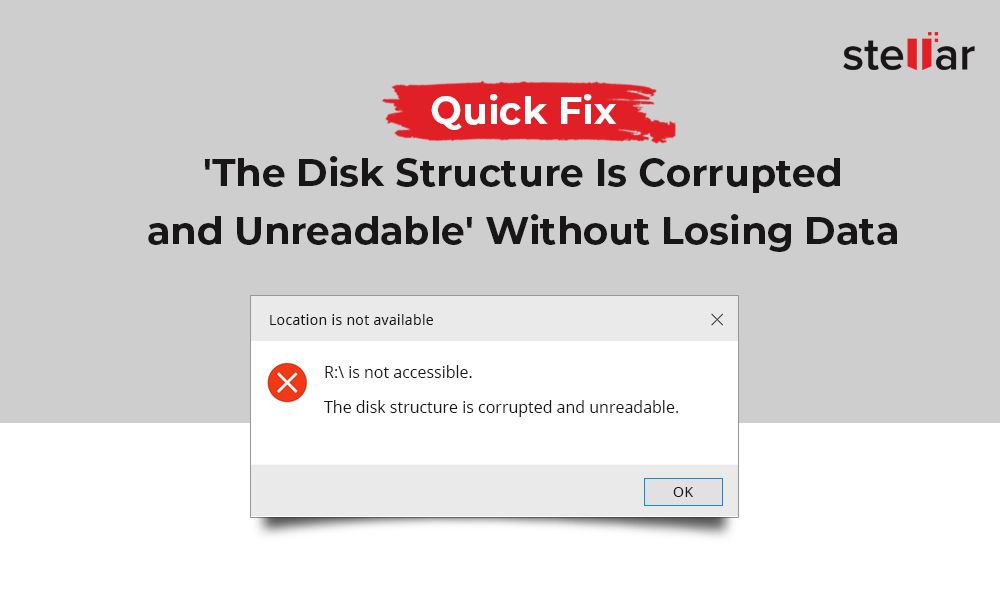There are a few potential reasons why a disk structure may become corrupted or unreadable:
Physical Damage to the Disk
If a hard disk drive (HDD) or solid-state drive (SSD) has experienced physical damage, this can lead to corruption of the disk structure and make data unreadable. Types of physical damage include:
- Head crashes – This is when the read/write head of an HDD makes forceful contact with the disk platter surface, damaging the thin magnetic film containing the data.
- Shocks/vibration – Rough handling of a disk, or operating it in a high-vibration environment, can cause internal components to fail or come out of alignment.
- Overheating – Excessive heat causes material expansion and magnetic charge loss.
- Water damage/oxidization – Liquid spills or moisture in a hard drive will corrode connectors and degrade platters.
Physical damage often requires specialized data recovery services to attempt extracting data, with no guarantee of success. SSDs are more resistant to physical damage than HDDs overall, but are still vulnerable to things like water/oxidization damage.
Logical Errors
The disk’s firmware, modules, partitions, and file system management structures can also become corrupted logically without physical damage. Common causes include:
- Unexpected power loss – A power outage or improper device shutdown during a read/write operation can cause the file system to be in an inconsistent state.
- Firmware bugs – Bugs in a drive’s controller firmware can trigger incorrect behavior.
- Driver issues – Similarly, faulty drivers on the host system accessing the drive can lead to corruption.
- Malware – Viruses and other malicious programs can intentionally overwrite critical disk areas to cause widespread corruption.
Logical corruption is often repairable through disk repair tools or reformatting, but preventative measures like proper shutdowns and up-to-date firmware/drivers are key.
Common Signs of Disk Corruption
Some common symptoms that point to disk corruption include:
- I/O errors when trying to access files or boot the system
- “Sector not found” messages
- Inability to open folders/directories
- Strange behavior like very slow performance
- Missing/inaccessible partitions
- Invalid file system structures
- Boot failures/crashes
In many cases disk corruption will produce distinctive error messages pointing to structures like the Master File Table, GUID partition table, or file system tables being faulty.
Repairing a Corrupted Disk
When attempting to repair disk corruption, the specific method depends on where the damage is located. Some steps to try include:
- File system check (fsck) – Run the file system check command like “fsck -y /dev/sdX” to scan and repair corrupt file systems.
- Chkdsk – The chkdsk utility in Windows scans and repairs corrupt volumes.
- Format/repartition – For severe corruption a low-level reformat or repartition may be required.
- Replace corrupted system files – Repair toolkits can restore corrupted system files and structures.
- Update disk firmware – Get the latest firmware from the manufacturer to fix bugs.
Third-party recovery software also exists to repair certain types of logical corruption. But if the disk has physical damage causing corruption, solutions become less straightforward.
Preventing Disk Corruption
Steps that can help minimize or prevent disk corruption issues include:
- Use UPS battery backups – Protect against unexpected power interruptions leading to inconsistent state.
- Properly eject disks – Always eject external drives before unplugging to flush caches.
- Avoid excessive vibration – Cushion devices in high-vibration environments.
- Monitor SMART status – Tool can detect physical disk problems before failure.
- Update drivers/firmware – Use latest stable versions.
- Handle disks carefully – Avoid physical shocks and impacts.
Practicing safe computer use habits goes a long way toward avoiding both physical and logical disk corruption issues before they occur.
Recovering Data from a Corrupted Disk
If corruption has already occurred, the next step is trying to recover any lost data. Options include:
- Data recovery software – Specialized tools can read corrupted media and extract retrievable data.
- Data recovery services – For severe cases, a professional recovery company dismantles the drive in a lab to attempt extracting data.
- Restore from backups – Always having backups avoids reliance on damaged disks.
But while backup policies like the 3-2-1 rule provide an insurance policy against damaged disks, recovery software and services may still be necessary if current backups are lacking.
Reasons for Disk Corruption
To summarize, the main reasons disk corruption occurs are:
- Physical damage – Head crashes, dust, overheating, mishandling, etc. that damage disk surface and internals.
- Power outages – Unexpected shutdown during disk write leads to inconsistent state.
- Firmware bugs – Code defects in drive firmware that lead to misbehavior.
- Malware – Viruses intentionally overwriting critical structures.
- Driver problems – Bad disk drivers causing I/O errors.
Both physical and logical factors can affect integrity of critical structures like partition tables, file system metadata, boot records, and more. A disk’s volume can appear corrupted or unreadable as a result.
Conclusion
Disk corruption can stem from physical mishandling, power loss, software flaws, malware, and many other causes. Typical symptoms include I/O errors, inability to open files/folders, and operating system crashes. Repairing corruption depends on the exact issue, but can involve file system checks, repartitioning, data recovery software, and data recovery services in severe cases. Preventative steps include handling drives carefully, using UPS battery backups, keeping firmware and drivers updated, and following good computing practices. Though disk corruption can still happen unexpectedly, being aware of its common causes can help users be prepared in identifying issues and properly handling recovery.

